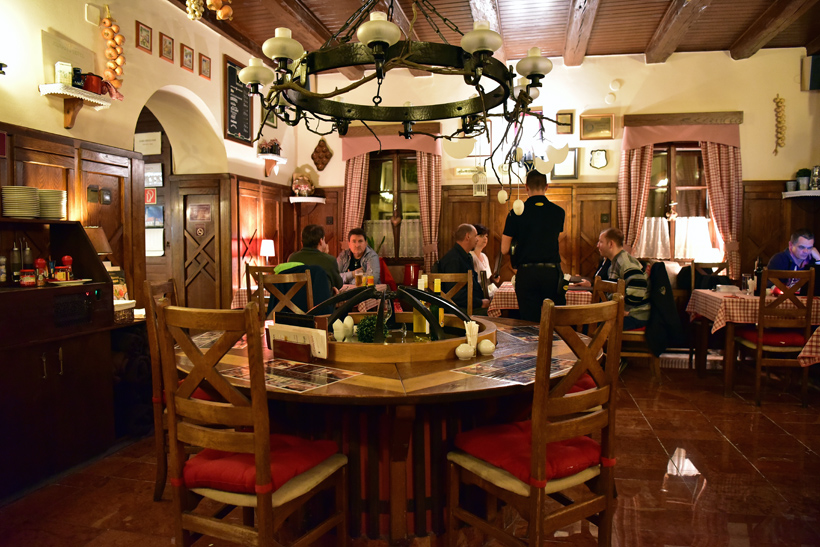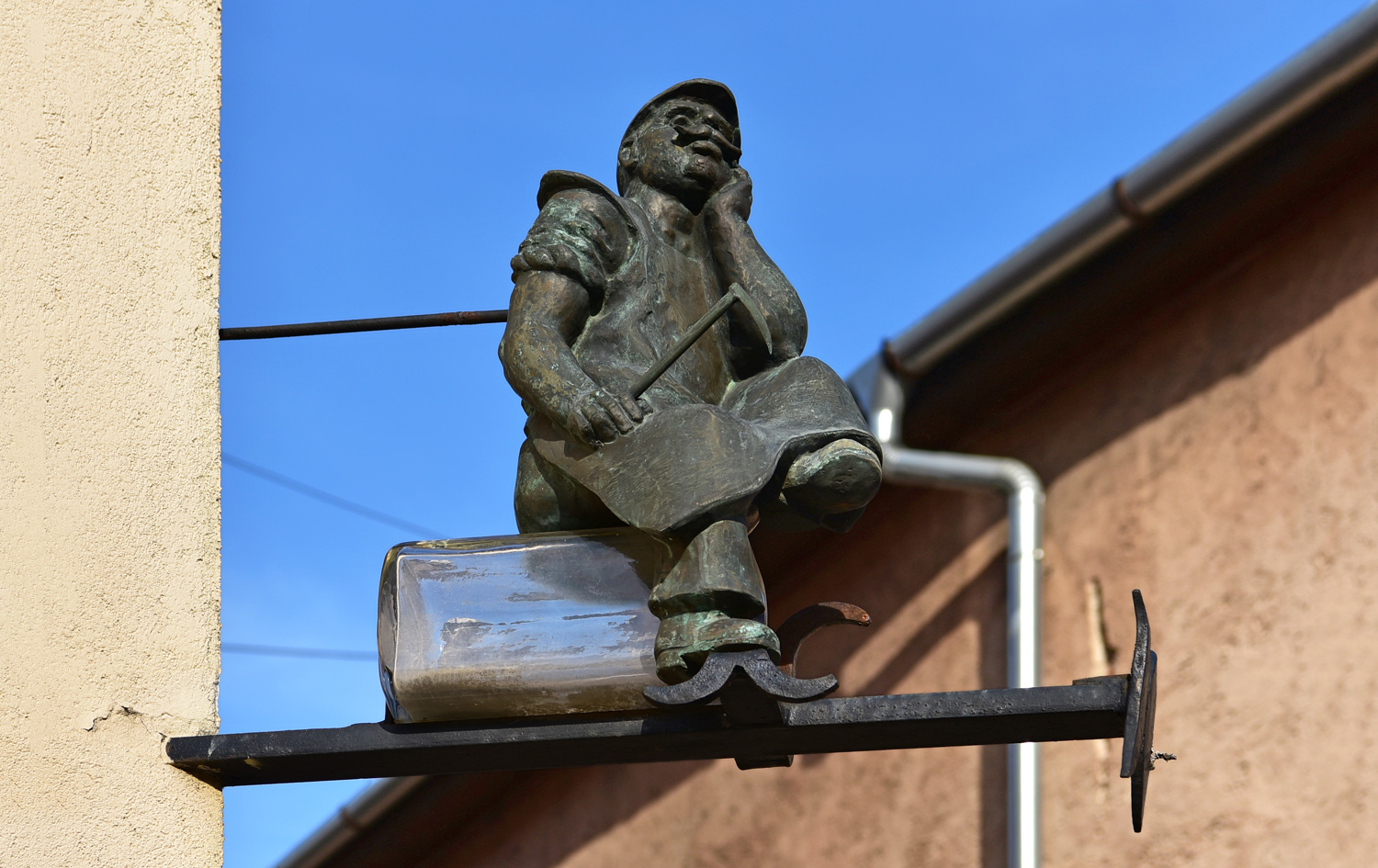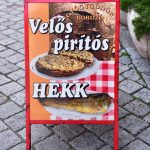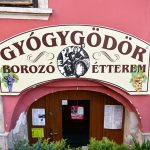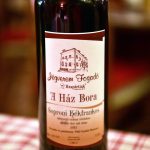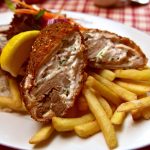Tucked up in the northwestern corner of Hungary, Sopron is one of the oldest cities in the country. It’s also in a significant wine-producing region, one of the few to make both reds and whites. One would logically expect an abundance of local food, recipes transmitted from one generation to the next, providing the perfect excuse to drink the local wine.
But one would be wrong. Strangely enough, Sopron isn’t known for its gastronomy. This becomes quickly apparent when searching Hungarian cookbooks and web sites. In the nearly 500 pages of George Lang’s Cuisine of Hungary, there are only two recipes from Sopron. The first one is called Spiced Red Cabbage, “an early nineteenth century recipe” that consists of red cabbage stewed in red wine with bacon, onion, garlic, caraway, pears, vinegar, and honey — “serve as accompaniment to roast pork or game”. The second is a strudel filled with preserves and a kind of frangipane. In the Hungarian-only book A magyarok asztalánál, Sopron is linked with only one recipe, a similar strudel served with a rum creme anglaise. All other cookbooks I checked are completely mum on the subject.
On the web front, the only page with substantial information comes from the official web site of the town of Sopron, a their page about gastronomy here. The beginning of the article doesn’t sound especially promising: “Sopron and its surroundings […] provides a rich culinary culture and traditions, a really wide range for both locals and visitors” blah blah blah. Accompanied by two carefully curated pictures, one showing of a pile of food that looks like a chicken kebab, plus a schnitzel, plus fried cheese, and the other showing two people smoking on a restaurant terrace. Then follow some trivialities about the region being a jack-of-all-trades of winemaking with white, red, and dessert wines that can go with any dish. Then, against all odds, things do get a little more interesting. The article starts talking about poncichters (a deformation of the German Bohnenzüchter, “bean growers”), winemakers who grow beans between their grape vines. As a result, the region created all sorts of bean dishes, from bean salad to bean strudel.
Finally we have it, the two specialties of Sopron cuisine: wine and beans! (And perhaps a particular fondness for strudel and cabbage.) The page concludes with two recipes that confirm it: Sopron Winemaker’s Cabbage (sauerkraut, onions, bacon, apple, white wine, sugar, potatoes, cumin, paprika; a little bit like George Lang), and Bean Pogácsa (just a pogácsa with beans in the dough). And other web sites do indeed associate Sopron with bean strudel recipes.
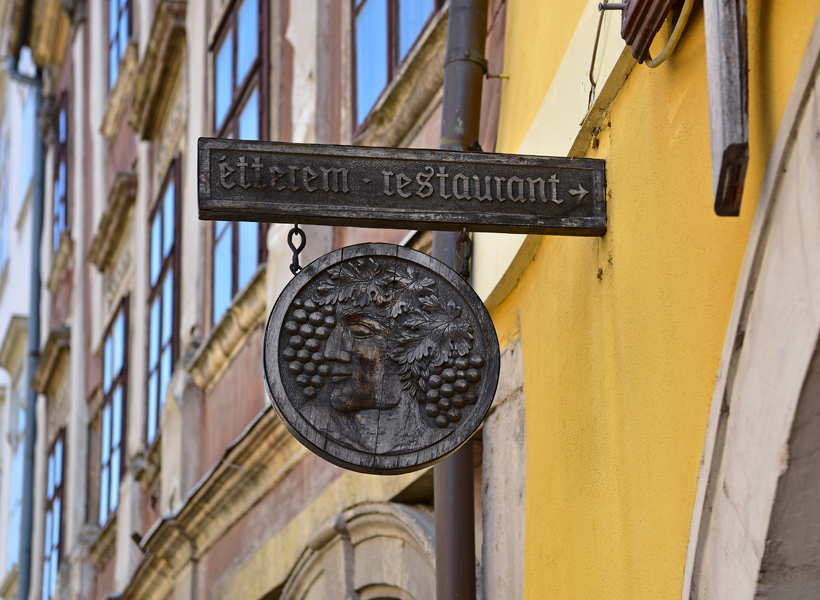
It remains to be seen how the written theory compares with the practice in local restaurants. Nobody seems to have written an article about Sopron cuisine in English, so I shall hereby be the first. In fact, I’m even going to write TWO. Boom! Top that! First I’ll look at restaurants and savory dishes, and next time I’ll cover desserts and sweets. In a region where visitors are way more likely to speak German than English, I’ve skimmed the menus of the best restaurants so you don’t have to. In fact, with all the information here, you can probably go to Sopron and have a better culinary experience than I did, because I didn’t know half of what I found out while preparing this post. So let’s get started!
First we’ll go out of the town center a bit. Whether you opt to tour the local vineyards, commune with nature in Fertő-Hanság National Park, or relax at the Sára thermal baths, you’ll head east of Sopron proper. After 20 or so kilometers, you hit the village of Hegykő, an unlikely touristic destination and a one-liner on Wikipedia. Right next to the aforementioned thermal baths sits Tornácos Ház (meaning “the house with a porch”), a hotel cum restaurant cum local product store.
The menu is as good an introduction to Hungarian cuisine as any: plate of local charcuterie and cheese; foie gras terrine; steak tartare (reminds me of Czech Republic); Hortobágyi palacsinta (more on this later); Hungarian beef goulash in a small cauldron (Hungarian goulash is more a soup than a stew); Hegykő creamy vegetable soup with dill meatballs; catfish soup in a small cauldron; catfish paprikás (a goulash with a thick sauce and sour cream) with bacon and cottage cheese pasta; grilled zander with creamy tomato chutney and noodles; Tornácos chicken roulade wrapped in ham and filled with cheese and peas; pork schnitzel with pumpkin seed oil potato salad; pork roast stuffed with bacon, onion and mushrooms, served with onion potato purée and onion fritters; roasted pork knuckle with with fried potatoes, mustard and fresh horseradish; beef pörkölt (a goulash made with a thicker sauce) with homemade chive galuska (similar to spaetzle). Not a single dish with beans, but there’s one with both red cabbage and strudel: grilled duck breast with Hegykő red cabbage, potato strudel, and wild mushrooms. My quest for a local steak recipe also continues in Hungary (it started in Moravia, here), since nearly every menu has at least one option. Here at Tornácos Ház, it’s a ribeye steak with herb butter, spicy potatoes, grilled vegetables, fried egg, and pepper sauce. I think you’re supposed to pick from those, not get all of them (though, considering the hefty portions restaurants often serve, I’m not completely sure).
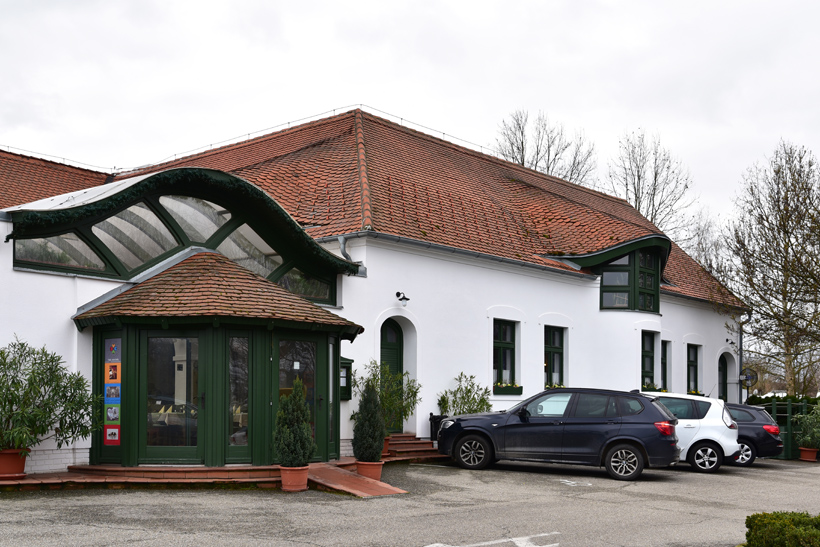
The foie gras terrine is made with chunks of goose foie gras in a kind of mousse that’s lighter in taste but quite heavy in texture; that mousse makes the dish less enjoyable. It’s served with tomatoes, red onions, green peppers, lettuce, and sprouts, which is a fresh departure from the fruit preserves that often come with foie gras. After all, a salad makes a perfect accompaniment for any other terrine.
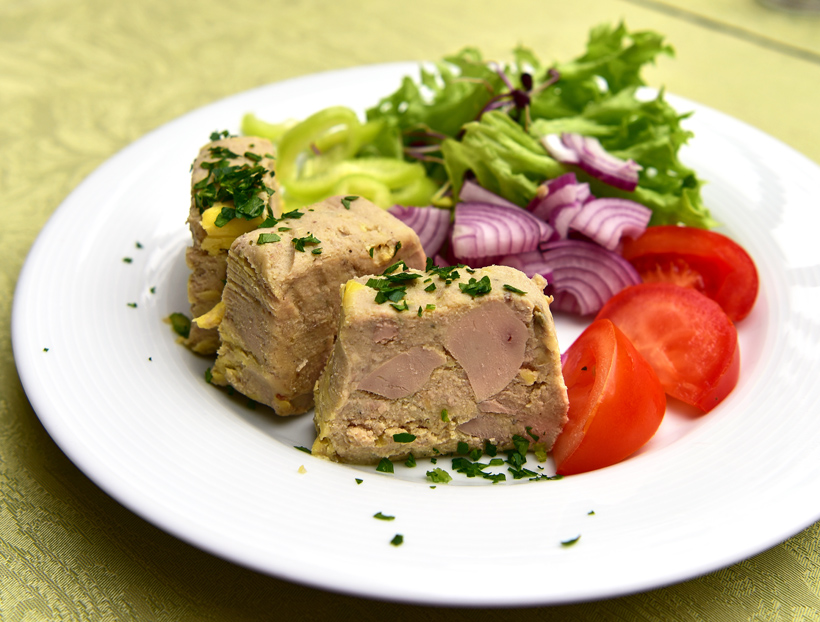
Since we were there around Easter, Tornácos also offered a lamb-heavy special menu. This is about the only occasion when Hungarians eat lamb (a bit like most Americans, come to think of it), so I was rather curious. But lamb or not, the restaurant seems to fall back on classic Hungarian recipes. The lamb stew with wild mushrooms (lots and lots of them), is served with cheese galuska.
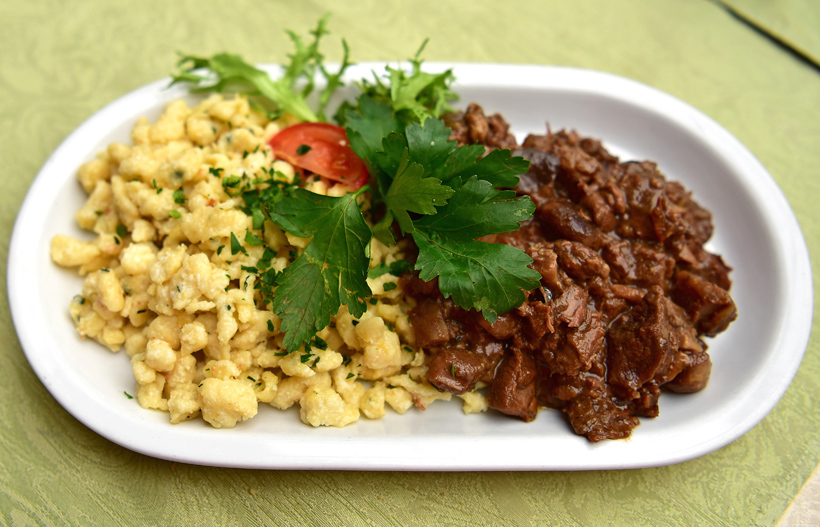
The lamb roulade with herbs and parsley sauce isn’t very exciting, and the meat is terribly overcooked. The meat is filled with a mixture of bacon, potato, and red pepper and the sauce is very thick. It comes with zucchini-potato pancakes.

This is also my first encounter with Sopron wines! The Winelife Supernova 2014 is a semi-sweet Müller-Thurgau that reminds me a lot of the Rieslings from the Finger Lakes region in New York State, but without the minerality. This isn’t surprising, since Müller-Thurgau, one of the most widely planted grapes in Germany, is a crossing of Riesling with Madeleine Royale. It’s a nice, light wine that the producer describes as an “ideal choice for young people, initial wine consumers, and beautiful ladies” (apparently with a straight face). The Winelife Hegykői Kékfrankos 2012 is also nice and light, just… red.
Let’s talk more about the local wine for a minute. Sopron’s vineyards get more humidity and less sun than in other parts of Hungary, and winters are milder. Taken all together, this probably explains the light wines that they produce. Allegedly, this is the first Hungarian region where red wine was made, and Sopron is best known for its Kékfrankos. The recording on the little tourist train spins an amusing yarn about its etymology: when Napoleon’s soldiers stayed in Sopron, they would buy wine in addition to their military rations. They had two kinds of currencies, white francs and blue francs, the blue (blue is kék in Hungarian) being more valuable; so the winemakers only sold their best wine (Kékfrankos, naturally) for blue francs. Take this with a grain of salt, however, as the story has been debunked here. Culinaria Hungary claims that Sopron’s Kékfrankos goes particularly well with smoked meats, whether it’s used for cooking or for drinking.
Other Sopron reds include Zweigelt, just like in neighboring Austria. Among the whites, Grüner Veltliner is quite popular, again like in Austria. You also find Zenit and Irsay Oliver, both crossings invented by Hungarian viticulturists in the 20th century. While this is not an exhaustive list (I mention other varietals even in this post), all Sopron wines are generally on the lighter side, though pleasant and easy to drink. Sopron’s production remains fairly obscure (granted, that’s true about most Hungarian wines outside of Hungary), and I can think of more famous regions for both whites and reds. Still, in the U.S.A., the curious can buy a few bottles from Blue Danube here.
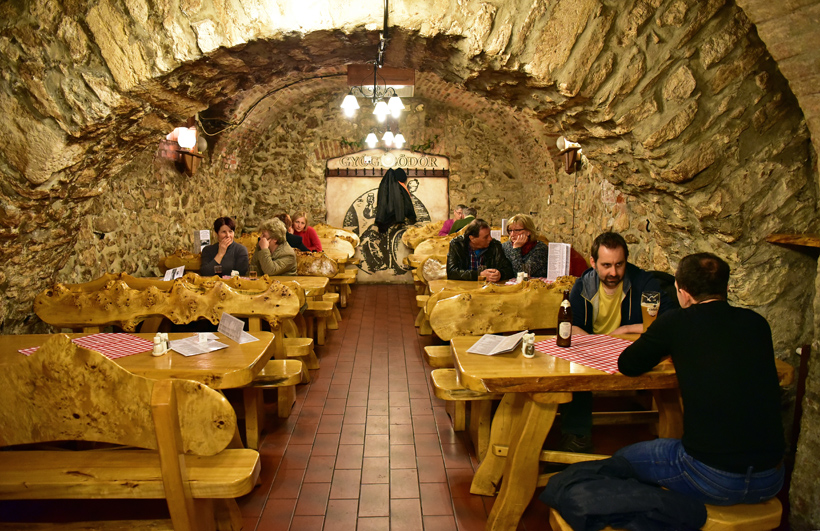
For a tasting, head back into the center of town to find the Gyógygödör Wine Cellar, whose name means “medicinal pit,” suggesting that wine is to be used as curative or preventive medicine. This place is famous (and ancient) enough to be mentioned by name in George Lang’s Cuisine of Hungary. It is indeed a fine example of what’s called a borharapó (literally, “wine-biter”), the cavelike basement of an old house, wherein one can sip wine under vaulted ceilings. Just look at that mouth-shaped entrance leading below street level, ready to swallow you into a life of vinous debauchery.
You can eat at Gyógygödör, too! On the menu: breaded and fried camembert with blueberries; breaded and fried everything (vegetables, meat, offals); red wine beef pörkölt with haluska; cellar pörkölt; tripe pörkölt; tripe and brain pörkölt; stuffed cabbage; breaded and fried pancake with brains; pork roulade with brains; toast of lard with red onion. Yes, it looks like the chef’s got a few culinary fads. And aha, one dish with beans, a bean goulash! But the one dish ordered by the true connoisseur isn’t any of those — it’s the brain toast.
The brain toast, aka velős pirítós, is the kind of culinary specialty that can only exist in Hungary — where else will you see something like this on a billboard outside, meant to attract customers? Velő in Hungarian can mean both bone marrow and brains (short for agyvelő), but it is the latter you’re getting here. And it’s just that: a large slice of toasted bread spread with a lot of brains. The brains are finely chopped, sautéed in copious amounts of fat, and generously seasoned with salt and black pepper. The result is quite spicy and very nice, although very rich. I like it! It also tastes a little bit livery, so I wonder if there’s some chopped liver mixed into it, just to make it even more Magyar. Many recipes Ive seen will also add chopped onion.
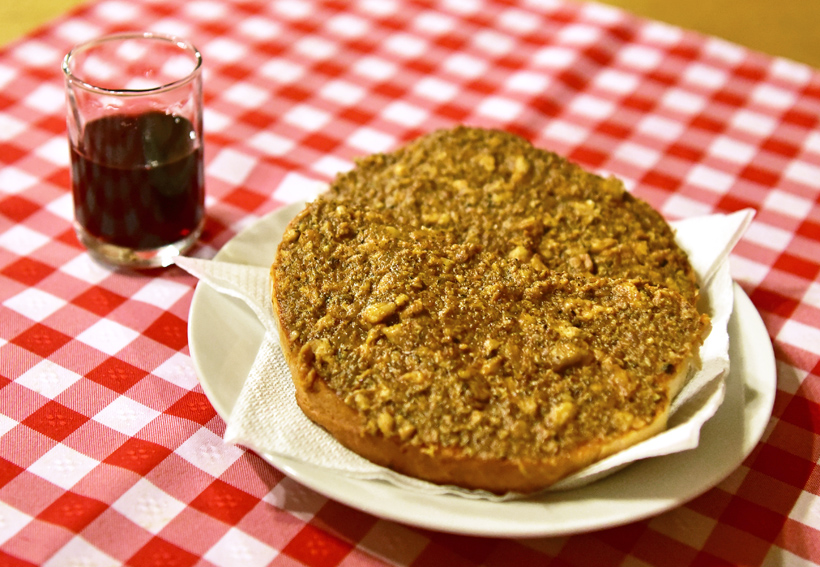
This spicy, greasy toast pairs perfectly with a glass of red. Gyógygödör offers a wide range of wines from Vincellér: Grüner Veltliner, rosé, Kékfrankos, Cabernet Sauvignon, and a couple of red blends. The Kékfrankos and Cabernet Sauvignon are both very light but good. The nose isn’t very pronounced in either case, but you can easily finish a bottle. Maybe that’s why the place is called a wine-biter…
More wine can be had at Erhardt, a restaurant cum hotel cum wine cellar cum wine store that stands among the best in town. By now the menu should seem familiar: beef tartare; goose foie gras; beef broth with liver dumplings; garlic cream soup; catfish paprikás with oyster mushrooms and parsley gnocchi; turkey breast “cordon bleu”; crispy leg of duck and duck breast with cabbage noodles; plus the two classic dishes below. One option with beans, the “assorted” salad: csalamádé (pickled cabbage and mixed vegetables), beans, cucumber, potato. And for the research on my future Eastern European steak recipe: fillet of Angus beef, green peppercorn cream sauce, potato croquettes, and roasted vegetables.

The Hortobágyi palacsinta — a dish that’s arguably more representative of Hungary than goulash, since it’s not eaten anywhere else — is a crepe (or two!) filled with white meat and served with a red pepper sauce. The sauce is essentially just sweet red peppers and sour cream, and the crepes contain shredded chicken with just a little bit of sauce mixed into it. The crepes are pretty thick (maybe 1.5 mm), more like than Russian blini than French crêpes, but that works well because you can use them to mop the sauce. They’re also very soft, and very pale. A rather good dish, though I would put in a bit more meat, to help mitigate the too-many layers of crepe folded over one another.
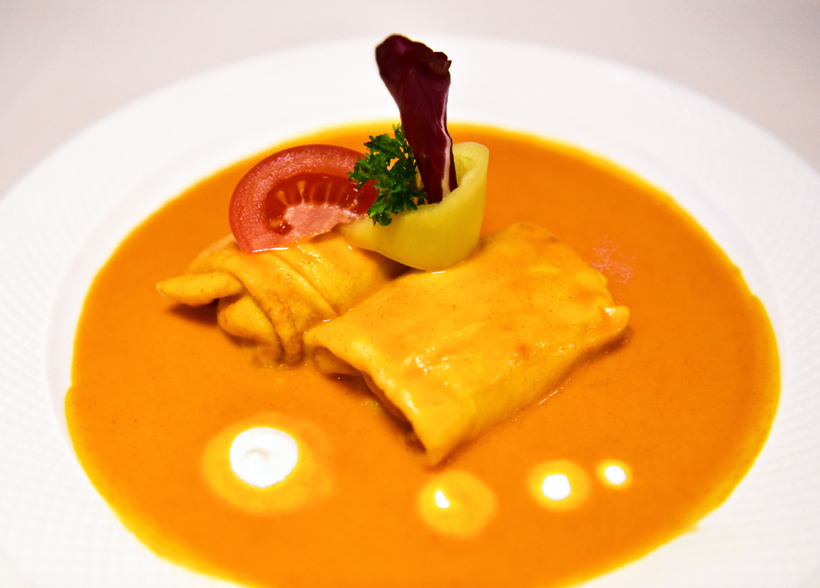
The veal paprikás is also very good. The meat is extremely tender, but not fatty. The sauce is a standard paprikás sauce, pretty smooth, made with cream, paprika, and onion. It’s served with galuska mixed with pieces of scrambled eggs, maybe in an attempt to take the concept of egg pasta one step further. Oh, and the chef seems to decorate every plate with his signature garnish: an arrangement of raw tomato, green pepper, parsley, and radicchio.
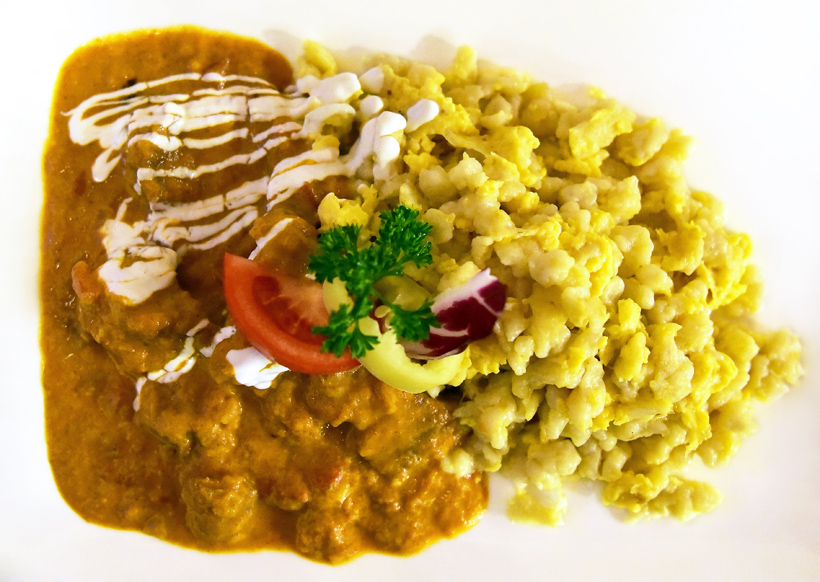
The house Kékfrankos 2014 is made by Luka, and it’s the best I’ve had in Sopron. While still light, it’s more full-bodied and tannic than the others I’ve tried. I wish I could come back to Erhardt just to try more wines!
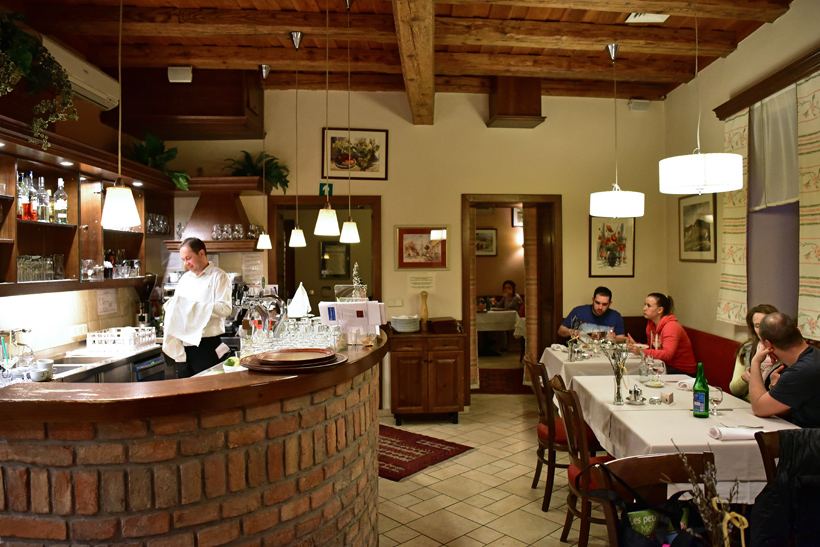
For a more rustic meal, try Jégverem Restaurant, the “ice house,” called thus because it sits on top of an 18th century ice cellar. This also explains the exterior shop sign of a man holding an ice pick, resting on a block of ice.
For this last menu, at Jégverem, I’ll skip listing the usual dishes, but of course they’re all here. More interesting are: the drunkard’s soup (chicken, vegetables, chicken liver dumplings, and beef); the grilled pike-perch fillet with herb butter, served with coriander and peas purée, and potatoes rosti. There’s also a whole page of chef’s specialties with exotic names and gargantuan portions: Aunt Irma’s favorite (see below); Mrs. Viczák’s secret (turkey breast stuffed with ham, corn, and herb butter, breaded and deep-fried, served with fries); Mr. Viczák’s secret (pork chop with bean, ham hock, and herb butter stuffing, served with fries); a pörkölt with the holy trinity of Hungarian meats (tripes, brain, pork knuckle); a pork chop, smoked sausage, and bean stew with potato croquettes. If you count the Jóka bean soup (which, if it’s from Jóka, isn’t really from Sopron), that makes a total of three dishes featuring beans in some function. And there are some more steak ideas: steak Hungarian style (with potato lecsó); steak with Kékfrankos, mushroom sauce and potato croquettes. And there’s another plate with Kékfrankos, the Kékfrankos beef pörkölt with galuska. And there’s a spicy Sopron wild boar roast with potato fritters — finally a local specialty of sorts? Wow!
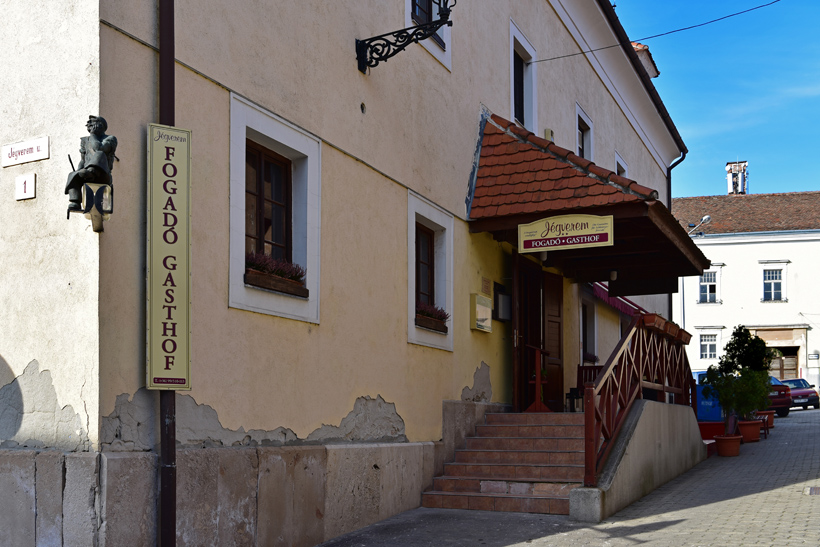
Here I particularly regret not having spent hours unearthing the nature of Sopron cuisine before my trip, because my choices don’t contain any Kékfrankos or beans or wild boar. But I do have the venison cutlets “forester-style,” and we can reasonably hope the venison didn’t come from New Zealand. The very sweet blueberry sauce tends to mask the meat’s taste, and isn’t quite what I expected from the forester style. The surrounding potato croquettes are more or less average, with little taste.
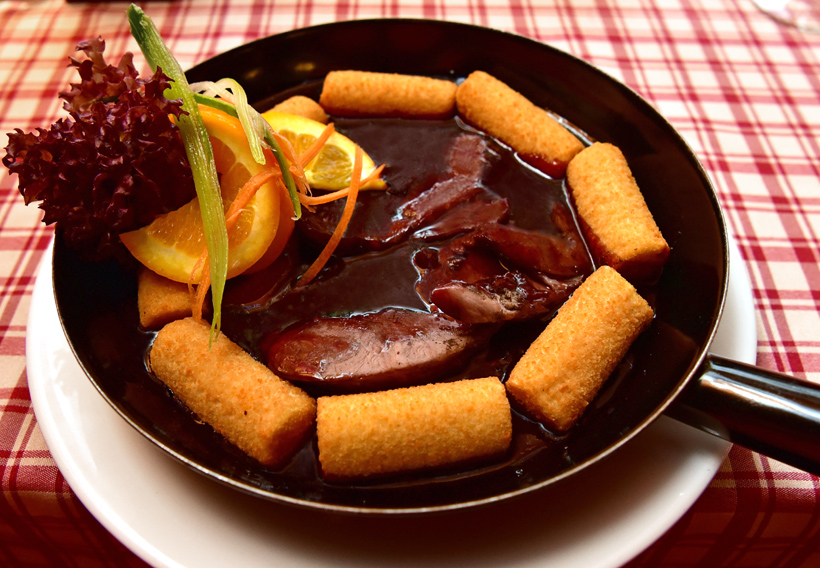
Aunt Irma’s Favorite is a chicken breast stuffed with goose liver, bacon, cream cheese, and a hint of mustard and chives, rolled in parsley breading, and served with both rice and fries. The goose liver (liver, not foie gras) is a little bit dry, but otherwise this is a pretty successful combination. It comes with a wedge of lemon that goes well once drizzled, so I guess the silly garnish that comes with every plate isn’t completely useless. The menu warns you: “it’s a hefty meal indeed!,” which in Hungarian parlance means it’s a portion for two: two cutlets, two starchy sides…
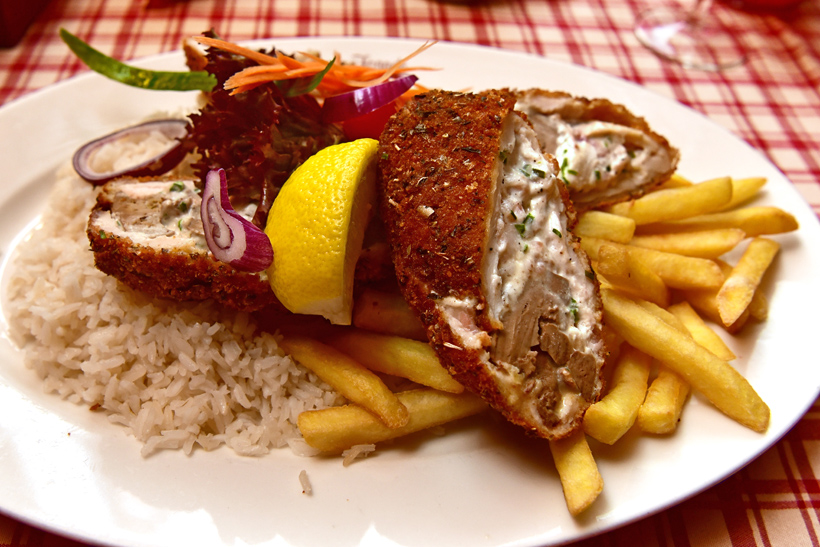
The house red wine, unfortunately, should be avoided: it’s just plonk. And on top of that, mine was corked! I guess that what happens when you buy wine from the ice man.
While the restaurants I’ve visited serve reasonable Hungarian fare, the identity of Sopron cuisine today remains tenuous, even after all this food. You can take a Hungarian dish (such as a pörkölt; a dish from a neighboring country is acceptable too) and add Sopron wine to it — or just drink the wine on the side. Every once in a while, you eat red cabbage or beans (the Hegykő red cabbage, the bean goulash, the occasional salad, soup, or stew with beans among other ingredients), though not really more often than you would in other surrounding regions. Like anywhere else, you can take a local product and append your town’s name to the dish on the menu for extra color (Hegykő vegetable soup, Sopron wild boar).
Let’s talk about the genuine Sopron strudel next time. Or not…
